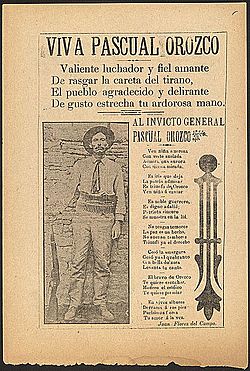First Battle of Rellano facts for kids
The First Battle of Rellano was an important fight during the Mexican Revolution. It happened on March 24, 1912, near the Rellano train station in Chihuahua. In this battle, government troops loyal to President Francisco I. Madero fought against rebel forces led by Pascual Orozco. Orozco's rebels won this battle.
Quick facts for kids First Battle of Rellano |
|||||||
|---|---|---|---|---|---|---|---|
| Part of the Mexican Revolution | |||||||
 A corrido extolling Pascual Orozco, the leader of the rebel army and commander at Rellano |
|||||||
|
|||||||
| Belligerents | |||||||
|
|
|||||||
| Commanders and leaders | |||||||
| Strength | |||||||
| 6000-7,000 | 6,000-7150 | ||||||
| Casualties and losses | |||||||
| 200 | 600 | ||||||
Why the Battle Happened
Orozco's Disagreement with Madero
Pascual Orozco was a strong supporter of the revolution against Porfirio Díaz, who was the dictator of Mexico. However, Orozco soon started to disagree with Francisco I. Madero, who became president after Díaz. Orozco felt that Madero did not appreciate him enough. He was especially upset because Madero chose someone else to be the defense minister instead of him.
Rivalries and New Alliances
During 1911, Orozco also started to get support from the powerful Terrazas family in Chihuahua. This family was a big enemy of Pancho Villa, another important revolutionary leader. This created a rift between Villa and Orozco. The final problem came when Madero made Abraham González the governor of Chihuahua. González was a close friend and mentor to Pancho Villa. Because of all these issues, Orozco officially started a rebellion against Madero's government in March 1912.
The Battle of Rellano
Federal Troops Advance Slowly
General José González Salas was sent from Mexico City to stop Orozco's rebellion. He started his mission on March 8. González Salas had about 6,000 soldiers. Their journey was very slow because Orozco's rebels had blown up railroad tracks and bridges. The soldiers had to stop and fix them along the way.
Splitting Forces and Surprises
General González Salas divided his army into three groups. Two cavalry groups were sent ahead to scout, but they lost contact with the main army. This meant that Orozco's troops, known as the colorados because of their red flag, were able to surprise González Salas's federal troops. The first few hours of fighting were small clashes that didn't decide anything. Eventually, the rebels pulled back to Rellano and dug in, waiting for the federal troops.
The "Crazy Locomotive"
Orozco's ally, Emilio Campa, came up with a clever and dangerous plan. He loaded a train engine with dynamite and sent it speeding towards the federal troops. This tactic later became known as the loco loco (crazy locomotive). Even though González Salas's soldiers removed some train tracks, the engine was going so fast that it jumped over the gap. It crashed into Orozco's train and exploded. Luckily, not many soldiers were hurt because most of them had gotten off the train when they saw the dynamite-filled engine coming.
Ambush and Retreat
The soldiers who had been on the train started moving north. Suddenly, about 1,000 of Orozco's rebels ambushed them, firing from the hills around them. A group of cavalry tried to surround the rebels but had to retreat when more rebels arrived. Another federal cavalry unit, led by Téllez, heard the fighting and arrived. The federal troops fought their way back towards Torreón. Téllez's unit bravely fought at the back to protect them, but they got separated from González Salas's main group again.
General González Salas's Fate
After reaching Torreón, General González Salas waited for news about his missing cavalry units. When no news came, he became very sad and passed away.
Orozco's Victory and Propaganda
The battle was a victory for Orozco. Even though most of the federal army was still ready to fight, Orozco used the news of his win for propaganda. The amazing "crazy locomotive" trick and González Salas's death made it seem like a huge disaster for Madero's supporters.
What Happened Next
Orozco's High Point
Orozco's victory at the First Battle of Rellano was the peak of his rebellion. He controlled almost all of Chihuahua. The only town he didn't control was Parral, which was protected by Pancho Villa's soldiers. Villa stayed loyal to Madero during this time. This was partly because he respected Governor Abraham González, and partly because he had his own rivalry with Orozco.
The Tide Turns
Orozco's next logical step was to attack Parral. In the Battle of Parral, Orozco eventually took the town. However, Villa's strong defense bought enough time for General Victoriano Huerta to arrive in Chihuahua with a new federal army. In the Second Battle of Rellano, things changed. Huerta defeated Orozco, who tried to use a similar "crazy locomotive" trick, but it didn't work this time. After this defeat, Orozco's rebellion fell apart, and he had to escape to the United States.
See also
 In Spanish: Primera Batalla de Rellano para niños
In Spanish: Primera Batalla de Rellano para niños

